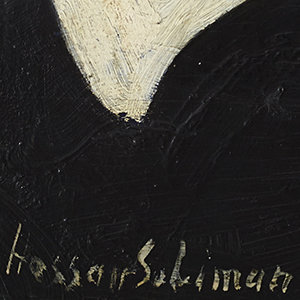Born in 1928, in Cairo, Egypt, Hassan Soliman was a painter, writer, illustrator, and a gifted draughtsman. He obtained his graduate degree from the Cairo School of Fine Arts in 1951. The following...


HASSAN SOLIMAN, Egypt (1928 - 2008)
Bio
Born in 1928, in Cairo, Egypt, Hassan Soliman was a painter, writer, illustrator, and a gifted draughtsman. He obtained his graduate degree from the Cairo School of Fine Arts in 1951. The following year Soliman moved to Luxor in upper Egypt, where he worked as a painter in residence at the Luxor Atelier until 1953. The artist later traveled to Italy to study at the Accademia di Belle Arti di Brera, in Milan graduating in 1966. During that period, he toured Europe visiting museums and art galleries. Upon his return to Egypt, he taught at the Egyptian Open University and the Cinema Institute. He worked as a layout editor and art critic at the monthly cultural magazine al-Majjala. Soliman was an esteemed painter amongst Egypt's art circle. Still, he was an introvert who enjoyed the solitude. He was particularly inspired by Leonardo Da Vinci's dramatic themes, Goya's romanticism and Picasso's artistic genius following a tragedy such as in Guernica.
Soliman's paintings included reduced photographic depictions into semi-silhouettes painted with various degrees of shade. His work is intensified with layers of black and white in rich mixtures of reserved pink, blue, or green tints that accentuate the melancholic look typical to most of his characters. Soliman disregarded minute details. Instead, he depicted figures that allude to his subject, focusing on the composition as a whole. He favored still-life depictions, ones that reflect the exposure of light against shade and shadow. Also, Soliman produced several austere, full-size portraits featuring Egyptian women with a numb gaze. One of his earliest works entitled The Nuns, 1957, pervades a sense of serenity. It draws the viewer into the self-effacing and spiritual lifestyle of nuns. It is effortless for Soliman to reflect emotions of virtue and devotion onto the bowed faces of the nuns, which are painted against an ornamental background of crosses.
Although Soliman, at times, drew from the Western history of art, his figurative depictions maintained an Egyptian identity. In his notorious painting The Last Supper, 1967, which reflects distress in reaction to Egypt's defeat in the 1967 Arab-Israeli war, Soliman replaces the figure of Christ with that of an Egyptian man of North African features.
Soliman wrote profusely on art and literature. His books included The Artist's Freedom, Motion in Art and Life, How to Read a Picture, and The Psychology of Calligraphy, amongst others. Hassan Soliman passed away in 2008 in Cairo.
This is a short biography. The full version , along with research, CV and sources will be posted soon. Stay tuned and visit us often or become a member to be notified of our updates.
CV
Selected Solo Exhibitions
2002
Duroub Gallery, Cairo, Egypt
2001
Mashrabia Gallery of Contemporary Art, Cairo, Egypt
2000
The Sea, Hanager Arts Center, Cairo, Egypt
1997
Ahmed Al-Adwani Art Gallery, Kuwait City, Kuwait
1995
Cairo Atelier, Cairo, Egypt
1988
Silent Nature, Hanager Arts Center, Cairo, Egypt
Selected Group Exhibitions
2024
The Collector´s Eye XI, Ubuntu Art Gallery, Cairo, Egypt
2023
The Collector’s Eye X, Ubuntu Art Gallery, Cairo, Egypt
2022
From Mokhtar to Gazbia, ArtTalks Art Space, Dubai, United Arab Emirates
2021
The Collector’s Eye VIII, Ubuntu Art Gallery, Cairo, Egypt
2019
Selection, Zamalek Art Gallery, Cairo, Egypt
The Collector’s Eye VI, Ubuntu Art Gallery, Cairo, Egypt
Publications
1997
Hassan Soliman, This Other Aspect
1984
Hassan Soliman, The Artist’s Freedom
1980
Hassan Soliman, How to Read a Painting series
1977
Hassan Soliman, Scripts from the Folklore
Collections
Ramzi and Saeda Dalloul Art Foundation, Beirut, Lebanon
Museum of Modern Egyptian Art, Cairo, Egypt
Bibliotheca Alexandria, Cairo, Egypt
Al-Sharekh Art Collection, Dubai, United Arab Emirates
Press
عبلة الرويني ونساء حسن سليمان أحمد فضل شبلول MEO.pdf
IraqiArt.com - رحيل الفنان التشكيلي المصري حسن سليمان.pdf
Short Film Forum – Film screening in memory of the artist Hassan Soliman - Bibliotheca Alexandrina.pdf
لوحات حسن سليمان.. تطارد الضوء وتلاحق الفراشات.pdf
حسن سليمان_ ترانيمٌ في عشقِ اللوحة.pdf
حسن سليمان_ لوحاتي وكتاباتي هي سيرتي الشخصية.pdf
لوحات الراحل حسن سليمان… إيقاع الطبيعة ولغة الصمت معرض لآخر أعماله في قاعة بيكاسو في القاهرة » Print القدس العربي Alquds Newspaper.pdf
Al-Ahram Weekly Special Hassan Soliman_ the outsider.pdf
ثقافة وحياة.. نساء الفنان حسن سليمان.pdf
AlWafd.pdf
وئام يوسف الأعمال الأخيرة لحسن سليمان.. الوجود العابر _ ثقافة جريدة السفير.pdf
فنان الصمت و الأسرار ... حسن سليمان.pdf
HassanSoliman_The bourgeoisie, real estate & nation-building, or how the Egyptian & Middle Eastern art markets operates_Press.pdf
مصرس _ الفنان حسن سليمان.pdf
البوابة نيوز_ بالصور.. افتتاح معرض الفنان الراحل حسن سليمان بقاعة بيكاسو.pdf
الأعمال الاخيرة ..معرض للراحل حسن سليمان – وطنى.pdf
HASSAN SOLIMAN Artwork
Become a Member
Join us in our endless discovery of modern and contemporary Arab art
Become a Member
Get updates from DAF
Follow Artists
Save your favourite Artworks
Share your perspectives on Artworks
Be part of our community
It's Free!
We value your privacy
TermsCookiesPrivacy Policies
Become a Member
Get updates from DAF
Follow Artists
Save your favourite Artworks
Share your perspectives on Artworks
Be part of our community
It's Free!
We value your privacy
TermsCookiesPrivacy Policies
Become a Member
Get updates from DAF
Follow Artists
Save your favourite Artworks
Share your perspectives on Artworks
Be part of our community
It's Free!
We value your privacy
TermsCookiesPrivacy Policies
Welcome to the Dalloul Art Foundation
Thank you for joining our community
If you have entered your email to become a member of the Dalloul Art Foundation, please click the button below to confirm your email and agree to our Terms, Cookie & Privacy policies.
We value your privacy, see how
Become a Member
Get updates from DAF
Follow Artists
Save your favourite Artworks
Share your perspectives on Artworks
Be part of our community
It's Free!
We value your privacy
TermsCookiesPrivacy Policies




